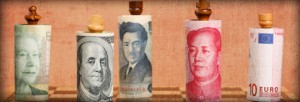New World Money
The construction of the IMF’s special drawing rights (SDRs) valuation basket is reviewed every five years by the IMF Executive Board. But it can be changed more or less frequently at the Executive Board’s discretion.
The new effective date for the revised basket is midnight on Sept. 30, 2016. China is its newest addition.
Membership in the exclusive SDR currency club has changed only once in the past 30 years.
That change took place in 1999, and was purely technical due to the fact that the German mark and French franc were being replaced by the euro.
Leaving aside this technical change, the SDR has been dominated by the “Big Four” (U.S., U.K., Japan and Europe) since the IMF abandoned the gold SDR in 1973. This is why inclusion of the Chinese yuan is so momentous.
Including the yuan is a “seal of approval” by the world’s major financial powers, led by the United States. It means China is a financial superpower and deserves a seat at the table when the international monetary system is reset.
The decision to now include the yuan in the SDR basket is part of a larger power play between China and the U.S. Since 2009, China has been one of the biggest lenders to the IMF.
You can think of this as a four-person poker game where a fifth player just sat down at the table with a large pile of chips. The poker game will now take on a new dynamic.

China does not strictly meet all the IMF criteria for inclusion in the SDR club. But use of the Chinese yuan in global trade does satisfy the test.
The yuan’s share of global payments has been steadily rising, from less than 1% in 2013 to about 2% in 2014. Yuan use is currently approaching 3% as shown in the charts below.
Use of Chinese yuan surpassed Australian, Canadian, Singapore and Hong Kong dollars, as well as Swiss francs, by 2014. It also recently passed the Japanese yen. This makes the yuan the fourth most used currency in the world after U.S. dollars, euros and sterling.
Where the Chinese yuan doesn’t meet IMF standards is in having an open capital account. China has also not always been transparent in their reporting of reserve positions.
Market confusion and turmoil have been caused lately by China’s efforts to move in the direction required by the IMF.
For two years prior to August 2015, China informally pegged the yuan to the U.S. dollar at a rate of about 6.2-to-1.
Maintaining the peg requires continuous market intervention by the People’s Bank of China, or PBOC (the central bank). Market forces tried to drive the yuan lower. This forced the PBOC to sell dollars and buy yuan to maintain the peg.
This operation drained about $500 billion from China’s $4 trillion in reserve assets in a matter of months. It is inconsistent with an open capital account in which market forces, not PBOC intervention, determine the value of the yuan.
But suddenly, in August 2015, China devalued the yuan in two steps, to a level of about 6.4-to-1. This was a shot heard round the world.
Epoch Times interview March 2016
The devaluation led directly to meltdowns in U.S. equity markets as the resulting strong dollar threatened to hurt U.S. exports and jobs. A stronger dollar also hurts earnings of U.S. companies with overseas operations. This damage has since become apparent in third-quarter corporate earnings reports.
From China’s perspective, the devaluation was a step in the direction of an open capital account. But from the world’s perspective, it was a continuation of the currency wars. Investors saw more devaluations coming and more damage to U.S. corporate earnings.
For now, China is defending the new peg with more intervention. You should expect further devaluations. You should also expect more market shocks in the near future as China stumbles its way to a freely traded yuan.
China has also improved the transparency of its reserve reporting, especially with regard to gold. From 2009–2015, China reported no increases in its gold reserves. Yet the evidence (from mining statistics and Hong Kong imports) was conclusive that China was, in fact, acquiring thousands of tonnes of gold.
In mid-2015, China suddenly announced that its gold reserves had increased by 604 tonnes. The total rose from 1,054 tonnes to 1,658 tonnes. Since then, China has updated its gold reserve position monthly (in keeping with IMF criteria).
All of these figures are misleading because China keeps several thousand tonnes of gold “off the books” in a separate entity called the State Administration for Foreign Exchange (SAFE). Small amounts are transferred from SAFE to PBOC monthly, and that becomes the basis for the official reserve reports.
The truth about China’s gold is hidden for now. It will be revealed later in the poker game when China needs to increase its pile of chips.
China’s case for admission into the SDR club is a mixed bag. The yuan meets the use criteria and is close on the reserve criteria. China does not meet the criteria for an open capital account and transparent reporting. Still, they are moving in the right direction.
In fact, none of this matters. The IMF’s decision to include the yuan in the SDR is a political decision, not an economic one. The green light to proceed has already been given by the IMF Executive Board.
The story of New World Money continues.
Regards,
Ed. Note: Sign up for your FREE subscription to The Daily Reckoning, and you’ll start receiving regular insights for specific profit opportunities. By taking advantage now, you’re ensuring that you’ll be financially secure for the future. Best to start right away – it’s FREE.


Comments: